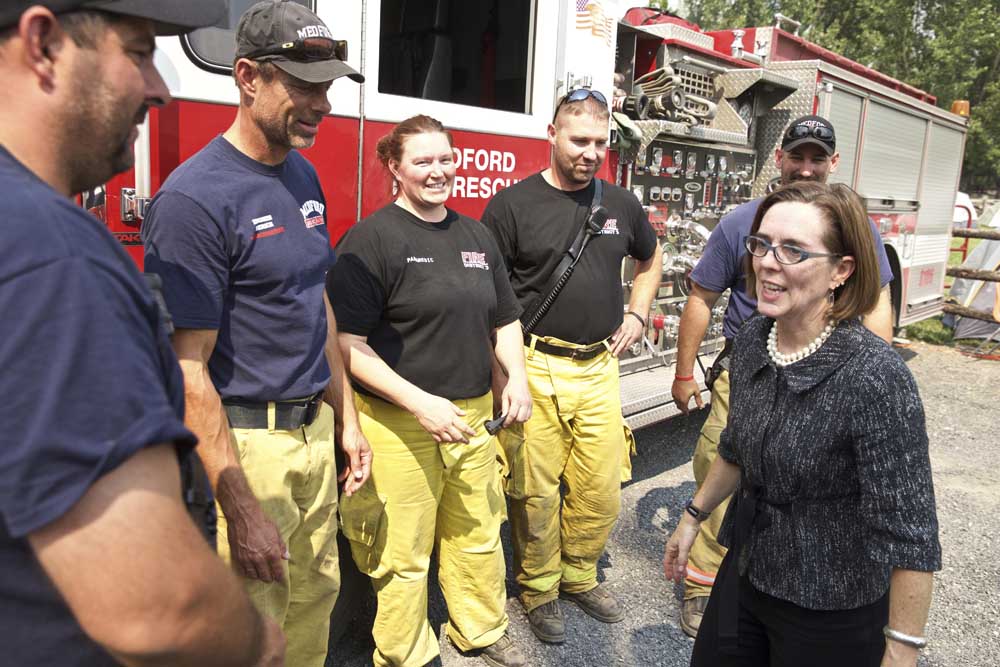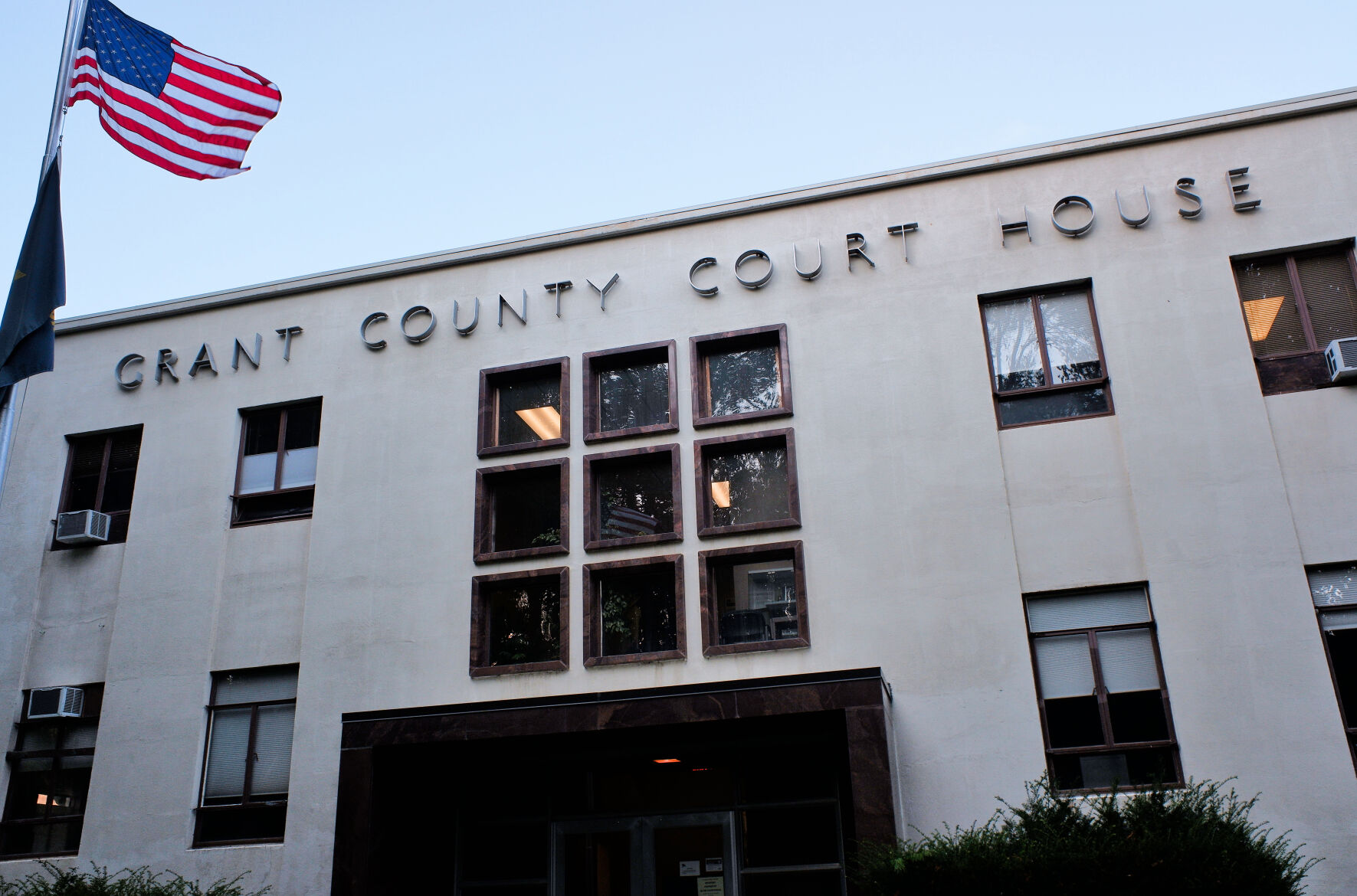Fire blazes on as governor activates National Guard
Published 5:21 pm Tuesday, August 18, 2015

- Gov. Kate Brown visits firefighters, and other government agencies that are working to contain the Canyon Creek Complex fire, Wednesday near John Day. The chief of the U.S. Forest Service says the intense wildfire season ravaging the West and maxing out fire crews and equipment is “the new normal.” (Thomas Boyd/The Oregonian via AP)
With a loud whoosh and blast of heat, flames shot high into the branches of several pine trees on a steep hillside in the heart of the Canyon Creek Complex Wednesday.
It has been a week since lightning touched off the nation’s highest-priority wildfire, and crews still have plenty of work cut out for them on the front lines.
Nearly 650 firefighters have come from around the country to battle the inferno south of John Day. Incident commanders figure they would have had more than 1,500 personnel on site, if not for the multitude of other fires raging across Oregon and the entire western U.S., placing an enormous strain on resources.
The Canyon Creek Complex is now 48,201 acres and remains completely uncontained. Another bout of high winds is in the forecast Friday, which should keep flames spreading quickly.
Gov. Kate Brown arrived to fire camp Wednesday at the Grant County Fairgrounds, where she announced she activated the Oregon National Guard to assist in firefighting efforts. An initial wave of 120 soldiers will begin training immediately before being deployed.
Earlier in the day, Oregon State Forester Doug Decker and Forest Service Chief Tom Tidwill joined Brown during a visit with victims who lost their homes to the Canyon Creek fire. The Grant County Sheriff’s Office now estimates 36 homes burned to the ground, although no injuries have been reported.
“There has been some tremendous work done to get everyone out safely,” Tidwill said.
By Wednesday afternoon, activity once again increased on the fire lines. Crews along Canyon Creek Lane were forced to retreat to the west side of Wickiup Campground as a giant plume of smoke lifted high over the ridge. Farther south, the town of Seneca, population 200, is on early watch for evacuation notices.
On the opposite side of the road, flames also crept in short grass and logs, occasionally jumping high enough to reach the lower branches of pines. Safety officers kept firefighters back to avoid becoming inadvertently trapped.
“It’s just how extreme it gets so quickly,” said Mike Gorsuch with the Oregon State Fire Marshal’s Office.
Damon Simmons, fire information officer, said it is easy for crews to lose their situational awareness and become surrounded if they are not careful.
Simmons, who usually works as a lieutenant with Portland Fire and Rescue, said all agencies are doing everything they can to contain the fire with the resources they have at their disposal. When people lose their homes, he said it’s a tough pill for everyone to swallow.
“You feel like you wish we could have done more, or that we could have been here earlier,” Simmons said. “It’s hard for people.”
Christie Timko, who has a private law practice and works as a judge for Harney County Drug Court, attended the meeting Wednesday at Canyon City Community Hall. Timko and her husband, Oregon State Police senior trooper Erich Timko, lived about 8 miles down the canyon south of Canyon City before losing their house Friday, in the blaze.
Timko said the meeting was respectful, though some people’s frustrations showed through — especially concerning perceived mismanagement of federal forests.
“(The message) was just a request that practices be put in place for the long-term health and safety of the forest and communities that surround it,” Timko said.
The Timkos are currently staying in a friend’s vacant home near Dayville. It has been a difficult adjustment, especially for their children, 6-year-old Cajsa Jo and 3-year-old Chance. But generous donations from the community have helped immensely, she said.
“My heart just goes out to everybody who has lost everything,” she said. “There are so many people who will suffer a lot more from this than we will.”
Brown told a gathering of media that the state will do everything it can to make sure residents have the tools, resources and knowledge they need to rebuild.
Brown and Tidwill also discussed the need to change how funding for firefighting works at the federal level.
Currently, the Forest Service pays for fighting wildfire out of its general fund budget. Brown said that is unrealistic under the looming threat of megafires, and said the agency needs access to disaster relief funding.
When the Forest Service pays for larger, more expensive fires, it must borrow money from other programs including fire prevention — a practice known as “fire-borrowing.” Tidwill said if they can stop fire borrowing, they could focus on treating more areas in the future to reduce wildfire severity.
“We just need to be able to accelerate the scope and pace of what we’re doing,” Tidwill said.
———
Contact George Plaven at gplaven@gmail.com or 541-966-0825.






